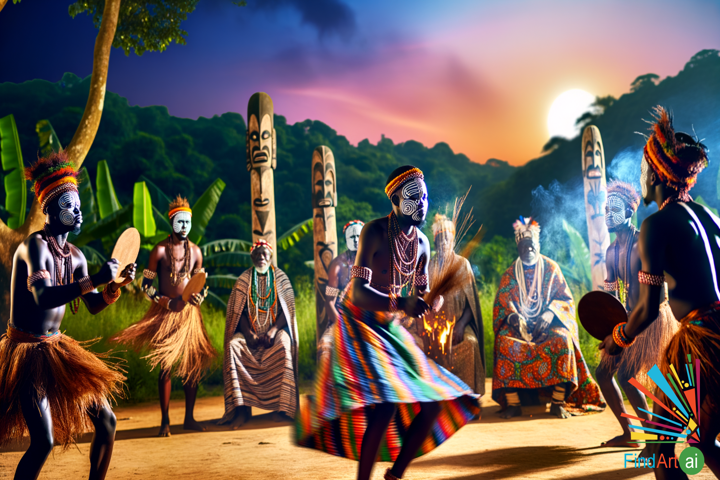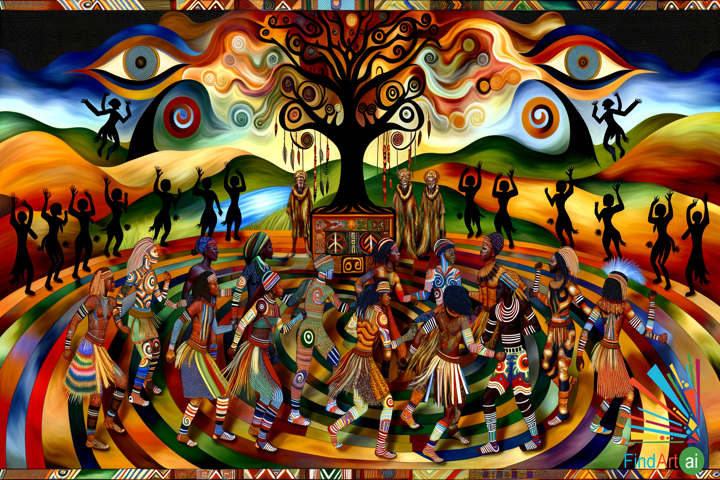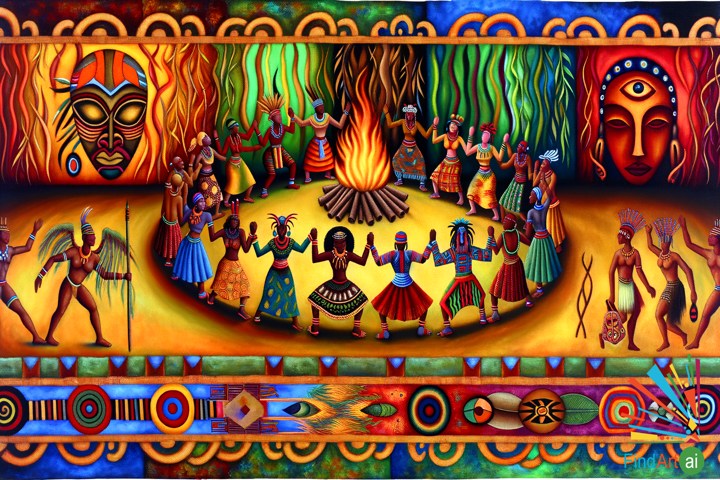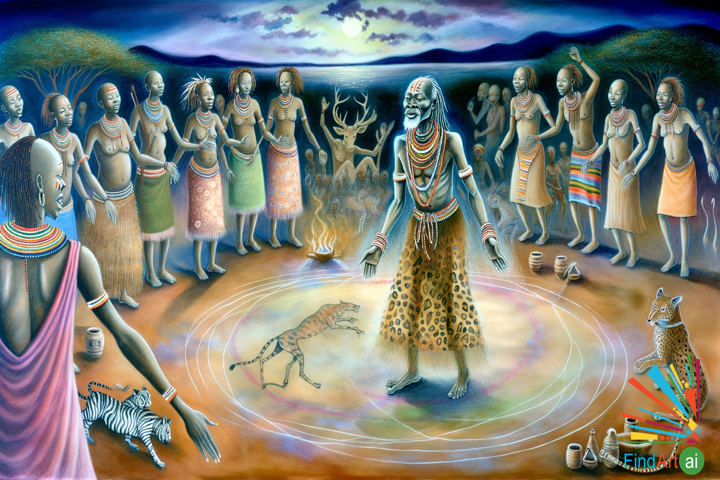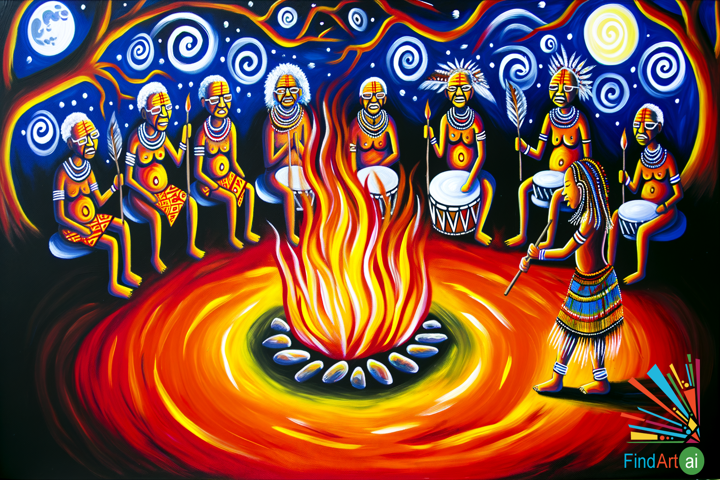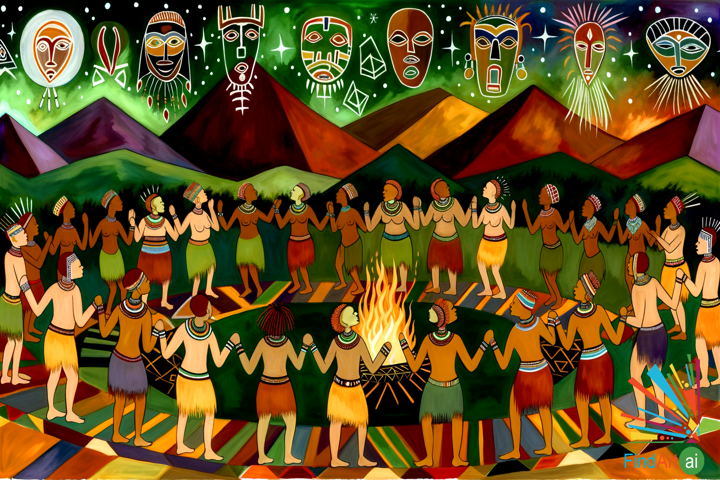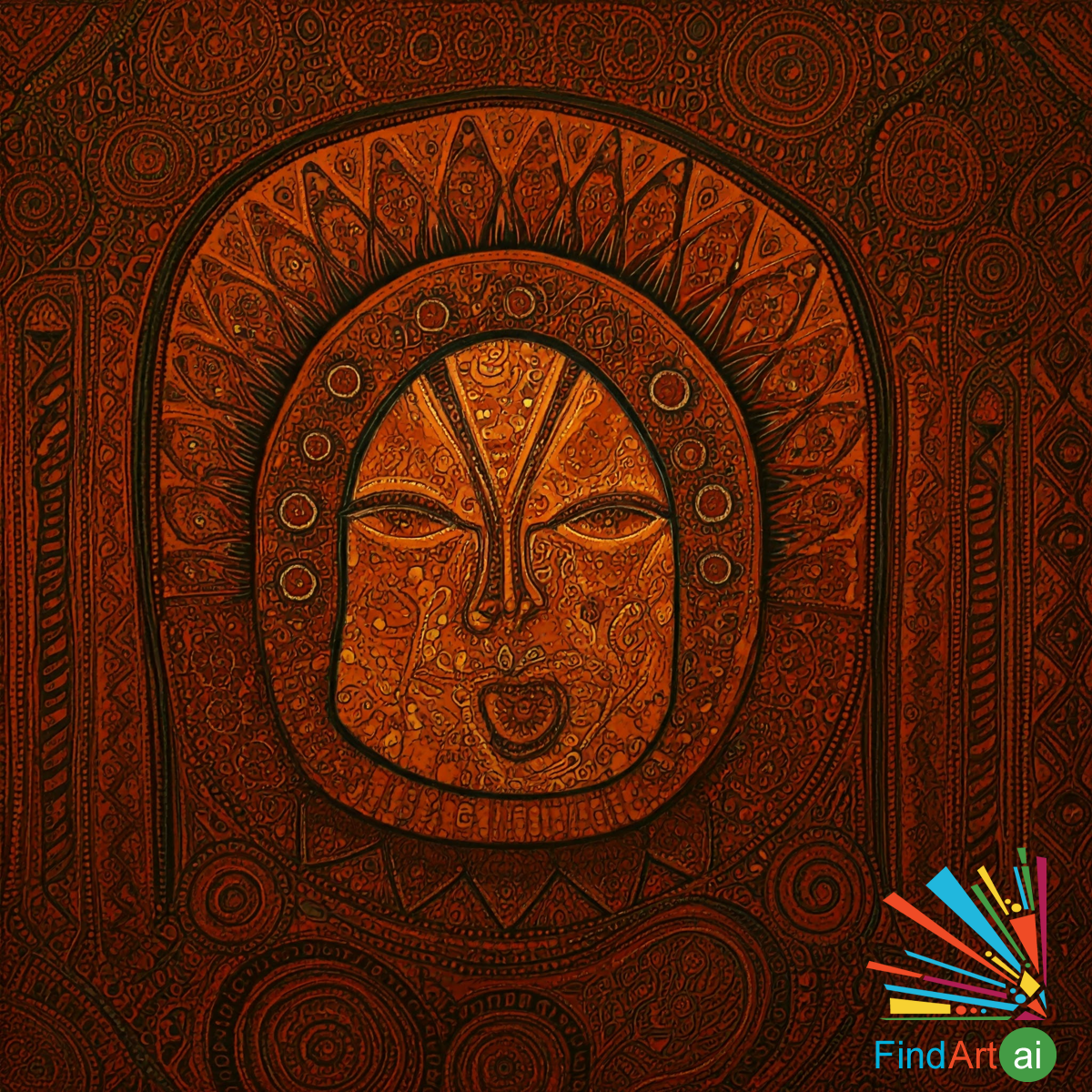
African Tribal Paintings with Connection to Ritual and Ceremony Theme
African Tribal Paintings with the Connection to Ritual and Ceremony theme serve as visual expressions of spiritual beliefs, communal identity, and traditional practices in various African cultures. These paintings are not just decorative but are deeply symbolic, often created for use in ceremonies or rituals that honor ancestors, invoke spirits, or mark significant life transitions such as birth, initiation, marriage, or death. African tribal paintings often utilize bold colors, abstract symbols, and geometric patterns that carry meanings tied to the spiritual realm, social structures, and the natural environment.
Key Characteristics of African Tribal Paintings with the Connection to Ritual and Ceremony Theme
- Symbolic Use of Patterns and Colors
- African tribal paintings typically feature abstract patterns, geometric shapes, and vibrant colors, all of which have symbolic meanings. These designs are often connected to the spiritual world or specific rituals, representing deities, ancestors, or the forces of nature.
- Example: The Ndebele people of South Africa and Zimbabwe are known for their distinctive geometric wall paintings, which are traditionally created to celebrate important community events like weddings or initiations. The patterns and colors used in these paintings are symbolic of the unity, strength, and identity of the community.
- Connection to Ancestors and Spirits
- Many tribal paintings are created as a form of communication with ancestors or spiritual beings. The imagery used in these artworks often represents ancestral spirits, mythical figures, or totemic animals, and is believed to invoke their presence or protection during rituals.
- Example: In some West African cultures, body paintings made for rituals or ceremonies feature abstract designs that are believed to invite ancestral spirits to guide and protect the participants during the ceremony.
- Ritualistic Body Painting
- Body painting is a prominent form of African tribal art closely tied to rituals and ceremonies. These paintings are temporary and serve to transform the wearer into a spiritual or symbolic figure during rituals, such as coming-of-age ceremonies or healing practices.
- Example: The Karo people of Ethiopia use intricate white and red body paint for ceremonies that celebrate strength, beauty, and warrior status. The designs also invoke ancestral spirits and are believed to protect participants from harm during the ritual.
- Ceremonial Wall Paintings and Murals
- Wall paintings and murals are often created on the exterior of homes, shrines, or communal spaces, symbolizing protection, fertility, and spiritual connection. These paintings are not only decorative but are integral to rituals that ensure the wellbeing of the family or community.
- Example: The Kassena people of Burkina Faso decorate their homes with mural paintings using natural pigments. These paintings often depict symbolic imagery connected to protection, fertility, and the life cycle, and are created during important rituals like housewarming or initiation ceremonies.
- Use of Natural Pigments
- The materials used in African tribal paintings often come from the natural environment, such as clay, plant dyes, and charcoal. These natural pigments are imbued with spiritual meaning, connecting the artwork to the earth and to the ancestors who are believed to reside in the natural world.
- Example: In the Himba culture of Namibia, red ochre, which is derived from the earth, is used both as body paint and in paintings on ritual objects. This color is associated with fertility, the life-giving forces of the earth, and the ancestors.
- Connection to Life Transitions
- Many African tribal paintings are created for ceremonies that mark significant life transitions, such as birth, initiation into adulthood, marriage, or death. The paintings are used to visually express the individual’s journey and their connection to the community and the spiritual world.
- Example: In the Maasai culture of East Africa, body paintings are used during coming-of-age rituals. The intricate designs not only celebrate the transition into adulthood but also symbolize the individual’s new responsibilities within the community and their connection to ancestral traditions.
- Abstract and Figurative Symbols
- African tribal paintings often use both abstract patterns and figurative imagery to convey meaning. The abstract designs, such as spirals, zigzags, or circles, may represent cycles of life, fertility, or protection, while figurative symbols, such as animals or human figures, often relate to mythological stories or spiritual beings.
- Example: In the Dogon culture of Mali, paintings created for rituals often feature abstract geometric shapes alongside figures representing ancestors or spirits, symbolizing the balance between the physical and spiritual worlds.
- Community Identity and Social Structures
- Tribal paintings often reflect the social hierarchy, values, and identity of the community. They are used in ceremonies to reinforce communal bonds and express the shared beliefs that unite the people.
- Example: The wall paintings of the Wodaabe people of Niger, created during their elaborate courtship ceremonies, reflect not only individual beauty but also the values of endurance, fertility, and social harmony within the community.
Common Themes in African Tribal Paintings with Connection to Ritual and Ceremony
- Ancestral Worship and Veneration
- Many tribal paintings are created to honor ancestors and seek their guidance or protection. These artworks often depict symbolic representations of ancestors or the spiritual realm, helping to maintain the connection between the living and the dead.
- Example: Paintings on ceremonial objects, such as shields or masks, often depict ancestral figures, ensuring their presence during rituals and reminding participants of the ongoing influence of their forebears.
- Fertility and Life Cycles
- Fertility is a recurring theme in African tribal paintings, especially in those used for rituals connected to agriculture, childbirth, or marriage. The artwork reflects the community’s hopes for abundance, growth, and continuity.
- Example: In some African cultures, body paintings featuring concentric circles or spirals are used during marriage or fertility rituals, symbolizing the cyclical nature of life and the hope for future generations.
- Protection and Healing
- Many tribal paintings are created for rituals aimed at protection or healing. These artworks often depict symbolic designs or figures that are believed to ward off evil spirits or bring health and prosperity to the community.
- Example: The Pende people of the Democratic Republic of Congo use ritual masks and body paintings in healing ceremonies, where the symbolic designs are thought to invoke spiritual protection against illness or misfortune.
- Initiation and Transition
- Initiation rituals, which mark the transition from childhood to adulthood, often involve body painting or ceremonial murals that symbolize the individual’s new status and responsibilities within the community.
- Example: Among the San people of southern Africa, initiation ceremonies feature body paintings that depict abstract and symbolic patterns, representing the initiate’s spiritual transformation and connection to the ancestors.
Vivid Ceremony: Ancestral Dance in African Village Captures Timeless Spirituality
"The Dance of Ancestors" vividly portrays a sacred ceremony in an African village, where dancers ado...
Echoes of Ancestral Rhythms: Vibrant Dance of Elements & Unity in African Tribal Art
"Echoes of Ancestral Rhythms" is a vibrant painting capturing the essence of African tribal ceremoni...
Eternal Echoes: A Vibrant Tribute to Africa's Ancestral Dance and Unity
"Eternal Echoes: The Dance of Ancestors" invites viewers to a vibrant canvas alive with the heartbea...
The Sacred Convergence: Celebrating an African Tribal Ritual with Dance and Spiritual Unity
"The Sacred Convergence" captures the vibrant essence of an ancient African tribal ritual. At its co...
Eternal Rhythms: Ancestors' Dance Unites Past & Future in Vibrant African Ritual
"Eternal Rhythms of the Ancestors" captures the vibrant energy of an ancient African ritual, where t...
Eternal Dance: Vibrant African Ceremony Celebrates Ancestral Spirits Under Starlit Sky
"Eternal Dance of Ancestral Spirits" captures the vibrant energy of an African tribal ceremony. Cent...

